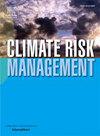CLIM-SEG:用于绘制热量和洪水风险图的可通用细分模型
IF 4.8
2区 环境科学与生态学
Q1 ENVIRONMENTAL SCIENCES
引用次数: 0
摘要
随着气候变化影响的不断升级以及城市化进程的加快,许多城市都将遭遇极端高温事件和严重洪涝灾害。目前的建模方法往往不能结合高分辨率、经常更新的数据源,如网络地图平台的航空图像,从而限制了其识别风险区域的有效性。为弥补这一不足,本文介绍了用于高分辨率城市高温和洪水风险评估的新型框架 CLIM-SEG,以弥补当前气候风险建模中的关键不足。该框架将航空图像的语义分割与加权和方法相结合,综合环境、社会经济和建筑数据,在普查区层面提供全面的风险评估。CLIM-SEG 将土地覆被数据与灾害和脆弱性因素综合在一起,得出 0 到 1 的风险分数。这种低成本、高效率的框架可以帮助城市规划者优先考虑用于洪水缓解和热适应的资源,解决当前方法的局限性,为城市规划和气候变化适应领域做出贡献。建议的方法结合了一个由 545 幅航空图像组成的定制数据集,其中包括 145 幅人工注释的分割图,以微调先进的语义分割模型。优化后的 Segmenter 模型的像素准确率达到 97.85%,关键城市特征的 "联合交集"(IoU)达到 0.9578,明显优于基线模型。波士顿被选为热量和洪水风险的理想代表,因为该市存在严重的城市热岛,并且容易受到沿海和沿河洪水的影响,由于海平面上升和降水量增加,预计到 2070 年将有超过 11,000 座建筑受到影响。洪水和高温风险模型的结果表明,南端人口普查区的洪水风险最高,加权分值为 0.825,而芬威-肯莫尔社区的人口普查区的高温风险最高,分值为 0.991。这两项结果也与波士顿的其他热量和洪水风险地图来源进行了验证。所提出的 CLIM-SEG 框架不仅能解决波士顿面临的挑战,而且有可能推广到其他应对气候变化影响的城市地区,为面对不断变化的气候进行风险评估和决策提供宝贵的工具。本文章由计算机程序翻译,如有差异,请以英文原文为准。
CLIM-SEG: A generalizable segmentation model for heat and flood risk mapping
With the escalating impact of climate change coupled with increased urbanization, many cities will experience extreme heat events and intense flooding. Current modeling approaches often fail to incorporate high-resolution, frequently updated data sources, such as aerial imagery from web mapping platforms, limiting their effectiveness in identifying areas at risk. To address this gap, the paper presents CLIM-SEG, a novel framework for high-resolution urban heat and flood risk assessment, addressing critical gaps in current climate risk modeling. This framework integrates semantic segmentation of aerial imagery with a weighted sum approach that integrates environmental, socioeconomic, and building data to provide comprehensive risk evaluations at the census tract level. CLIM-SEG synthesize land cover data with hazard and vulnerability factors, producing risk scores ranging from 0 to 1. This low-cost and efficient framework can enable urban planners to prioritize resources for flood mitigation and heat adaptation, addressing the limitations of current approaches and contributing to the field of urban planning and climate change adaptation. The propoosed methodology incorporates a custom-curated dataset of 545 aerial images, including 145 manually annotated segmentation maps, to fine-tune advanced semantic segmentation models. The optimized Segmenter model achieves a pixel accuracy of 97.85% and an Intersection over Union (IoU) of 0.9578 for key urban features, significantly outperforming baseline models. Boston is selected to represent an ideal representation for both heat and flood risk, as the city experiences severe urban heat islands, and is susceptible to coastal and riverine flooding, with over 11,000 structures expected to be affected by 2070 due to sea level rise and increased precipitation. Results from flood and heat risk models indicate that census tracts in South End have the highest flood risk, with a weighted score value of 0.825, while census tracts in the Fenway-Kenmore neighborhood show the highest heat risk, with a score of 0.991. Both of these results have also been verified with other heat and flood risk mapping sources for Boston. The proposed framework of CLIM-SEG not only addresses the challenges faced by Boston but also has the potential to be scaled to other urban areas dealing with the impacts of climate change, providing a valuable tool for risk assessment and decision-making in the face of a changing climate.
求助全文
通过发布文献求助,成功后即可免费获取论文全文。
去求助
来源期刊

Climate Risk Management
Earth and Planetary Sciences-Atmospheric Science
CiteScore
8.20
自引率
4.50%
发文量
76
审稿时长
30 weeks
期刊介绍:
Climate Risk Management publishes original scientific contributions, state-of-the-art reviews and reports of practical experience on the use of knowledge and information regarding the consequences of climate variability and climate change in decision and policy making on climate change responses from the near- to long-term.
The concept of climate risk management refers to activities and methods that are used by individuals, organizations, and institutions to facilitate climate-resilient decision-making. Its objective is to promote sustainable development by maximizing the beneficial impacts of climate change responses and minimizing negative impacts across the full spectrum of geographies and sectors that are potentially affected by the changing climate.
 求助内容:
求助内容: 应助结果提醒方式:
应助结果提醒方式:


